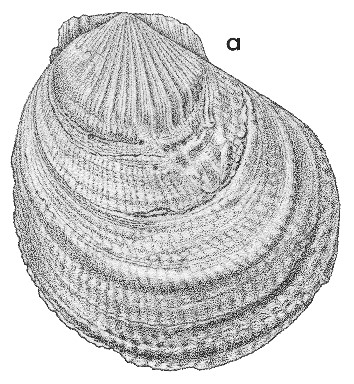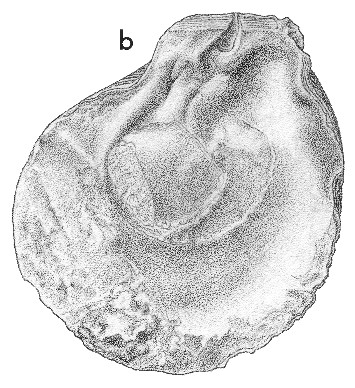
Revised descriptions of New Zealand Cenozoic Mollusca from Beu and Maxwell (1990)

 | Revised descriptions of New Zealand Cenozoic Mollusca from Beu and Maxwell (1990) | 
|
  (Pl. 17a): holotype of Hinnites trailli, Awamoa, Oamaru (probably mouth of Awamoa Creek), Altonian (TM2846, GNS) |
  (Pl. 17b): holotype of Hinnites trailli, Awamoa, Oamaru (probably mouth of Awamoa Creek), Altonian (TM2846, GNS) |
Beu & Maxwell (1990): Chapter 11; p. 179; pl. 17 a,b.
Synonymy: Hinnites trailli Hutton 1873b, p. 32; Chlamys oamarutica Murdoch 1924, p. 158; Austrohinnites trailli, Beu & Darragh 2001, p. 43.
Classification: Pectinidae
Description: Size moderate for genus (height 90 mm), robust; early Chlamys-like stage more or less equilateral, later stage oblique, irregular, ostreiform, attached to substrate by right valve. Change between 2 different styles of growth marked by strong hump or step in shell profile. Byssal notch well developed in neanic stage, apparently obsolete in adult. Sculpture on left valve Chlamys-stage of 11 or 12 narrow, widely spaced, broadly triangular, finely scaly, radial costae, with secondary and tertiary costellae (which eventually rival the primary costae in strength) appearing during growth. Surface of neanic stage except crests of costae covered with dense rasp-like microsculpture of very small intersecting scales. Neanic sculpture persisting onto early ostreiform stage then replaced by about 35 subequal, low, rounded, wavy costae bearing low, well spaced scales. Hinge without crura; resilifer prominent, oblique. Adductor muscle scar large, circular.
Comparison: Austrohinnites marwicki (Lillburnian-Waiauan), the only other species of the genus so far described from New Zealand, differs in having far fewer (only 20) radial costae on the ostreiform stage. The earliest local record of the genus is from the Kaiatan or Runangan of Nelson; other records are from the Duntroonian or Waitakian Cookson Volcanics in North Canterbury, from the Chatton Formation, Mataura River, Southland (Waitakian) and from the Otekaike Limestone near Duntroon, North Otago (Waitakian).
Hinnites has long been assumed to be a "form genus", i.e., a polyphyletic group in which several different Chlamys-like species have been included that have independently evolved a cemented habit. This was confirmed by Waller (1991, p. 22) and it is now clear that the southern Australian and New Zealand species are not closely related to the type species of Hinnites, H. crispa (Brocchi, 1814) (Pliocene, Italy). On the other hand, they are also not closely related to the western North American species H. giganteus (Gray, 1825), type species of Crassadoma Bernard, 1986 (Bernard 1986, p. 73), which Waller (1993) placed in its own tribe Crassadomini. Beu & Darragh (2001, pp. 41-43) proposed the genus Austrohinnites for Australian fossils of this group (type species: Hinnites corioensis McCoy, 1879, late Oligocene-late Miocene), and included the New Zealand species H. trailli and H. marwicki in the genus. All these species have distinctive shagreen microsculpture, not present in Hinnites, which should give some clue as to their origin.
Distribution: Altonian; Mount Harris Formation, Awamoa (type locality of Hinnites trailli); Target Gully Shellbed (type locality of Chlamys oamarutica); Old Rifle Butts, Cape Wanbrow; basal shellbed, Enys Formation, junction of Porter and Thomas Rivers, Castle Hill Basin. Rare or uncommon at all localities.
Cite this publication as: "A.G. Beu and J.I. Raine (2009). Revised
descriptions of New Zealand Cenozoic Mollusca from Beu and Maxwell (1990). GNS
Science miscellaneous series no. 27."
© GNS Science, 2009
ISBN
978-0-478-19705-1
ISSN 1177-2441
(Included with a PDF facsimile file
copy of New Zealand Geological Survey Paleontological Bulletin 58 in CD version
from: Publications Officer, GNS Science, P.O. Box 30368 Lower Hutt, New
Zealand)